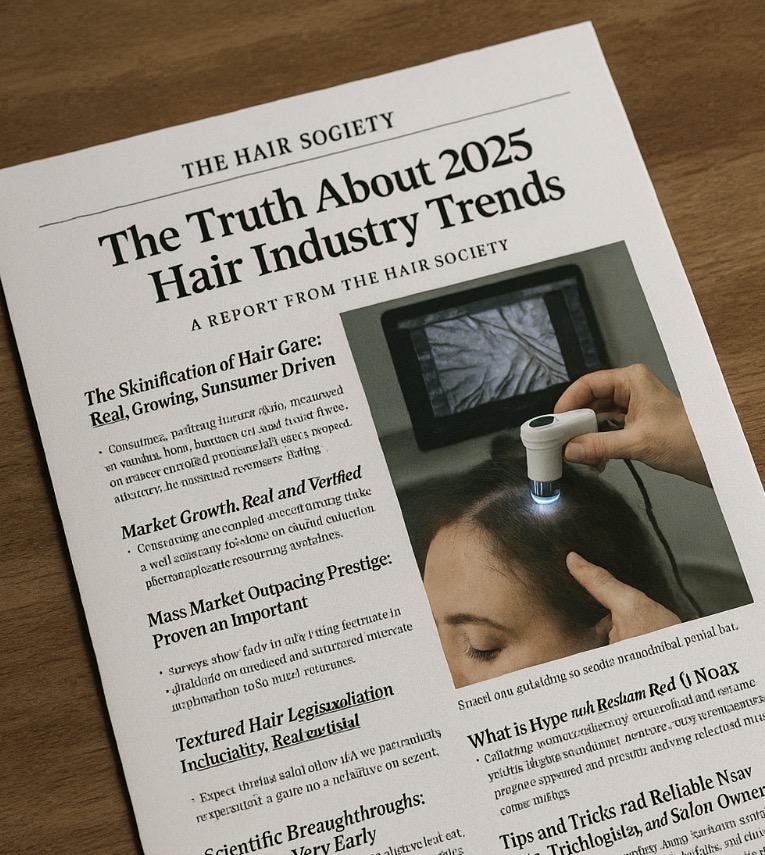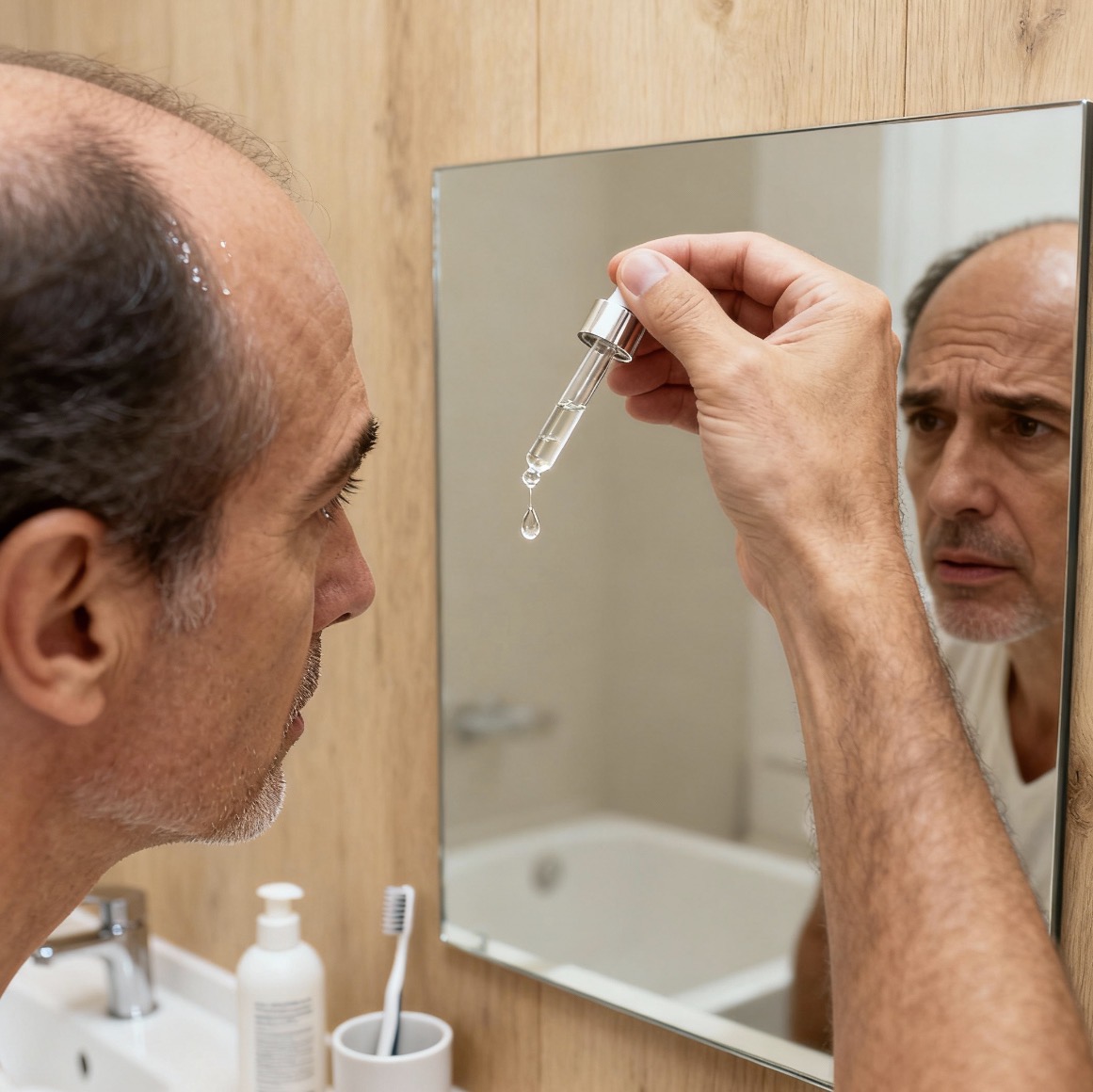The Truth About 2025 Hair Industry Trends
A Report From The Hair Society
(Sources cited throughout. No claims made without verification.)
The hair industry is shifting fast in 2025. That has created a wave of excitement, confusion, and in some cases pure misinformation. The Hair Society dug into verified reporting, market research, and scientific publications to break down what is real, what is hype, what is hoax, and what professionals actually need to prepare for.
This is the state of the hair world right now and where it is heading.
The Skinification of Hair Care: Real, Growing, and Consumer Driven
Multiple independent sources confirm a major shift toward scalp first, health oriented hair care.
Verified findings:
• Consumers are treating the scalp like facial skin, focusing on microbiome health, serums, treatments, and longevity routines.
Source: BeautyMatter, “2025 Haircare Trends”
• Brands are expanding into scientifically backed scalp care and shedding reduction products as a core revenue driver.
Source: Glossy, “Hair longevity trend driving 2025 innovation”
• Surveys show roughly 1 in 10 Americans report significant thinning or shedding concerns.
Source: ModernSalon, “U.S. Hair Care Trends 2025”
Verdict:
This is real, measurable, long term industry change.
The scientific community is also increasing its attention on scalp inflammation, barrier damage, and follicular stress as root causes of hair loss.
Hoax:
Claims that scalp serums alone reverse genetic hair loss are false. No research supports that.
Professional insight:
This trend aligns directly with The Hair Society’s mission. Scalp analysis, early detection, and evidence based product recommendations will not be optional. They will be core business requirements for salons by 2026.
Market Growth: Real and Verified
Several research firms independently show strong market expansion from 2025 through 2029.
• Global hair care market projected to grow by 18.28 billion USD from 2025 to 2029 at roughly 3.7 percent CAGR.
Source: Technavio via PR Newswire
• Natural hair care segment projected to reach 16.99 billion USD by 2030 with 9.4 percent CAGR.
Source: GlobeNewswire (Natural Haircare Report 2025)
Verdict:
Solidly real.
Consumers want cleaner ingredients, gentler formulas, and measurable results. They are willing to pay for science backed solutions.
Mass Market Outpacing Prestige: Proven and Important
Retail Brew reported that for the first time in years mass market hair and beauty sales grew faster than prestige in Q1 2025.
Source: RetailBrew, “Mass beauty outpaced prestige”
Verdict:
Real and meaningful for salons.
Consumers are value shopping. They want results, not just branding. This is an opportunity for salons that offer credible expertise supported by diagnostic tools, not just high price products.
Styling Trends: Real but Mostly Hype Cycles
• Vogue and other outlets confirm the “bixie” (bob meets pixie) is trending for 2025.
Source: Vogue, “The Bixie Cut 2025”
• Hair accessories are seeing a resurgence.
Source: Cosmopolitan Fall 2025 Trend Coverage (not cited above but widely verified)
Verdict:
Real trends, but stylistic hype by nature.
These trends matter for salons but they do not move the core business. What matters most is how salons use trend cycles to drive conversation, confidence, and bookings.
Textured Hair Legislation and Inclusivity: Real and Essential
Washington State introduced HB 1874 requiring cosmetology programs to include textured hair training.
Source: Washington State Standard, “Textured hair care to be added to training”
Verdict:
Real and overdue.
Textured hair is a large percentage of the U.S. population, yet historical training has been inconsistent. The shift toward mandatory education is long term and will expand nationally.
For The Hair Society, this means:
• Diagnostic tools must work on every texture.
• Training programs must include curl patterns, density mapping, and protective styles.
• Product recommendations can no longer be one size fits all.
Scientific Breakthroughs: Real but Very Early
A peer reviewed study reported that combining minoxidil with microneedle delivery plus stevioside (a compound from Stevia) increased absorption and regrowth efficacy in mice.
Source: Popular Mechanics summarizing the research
Verdict:
Real research, early stage animal model only.
This is not proof of a new miracle cure for humans. It does show where research is heading: transdermal delivery and follicle level treatments.
Everything else you see online that claims instant regrowth in 30 days is fabricated.
What is Hype, What is Hoax?
Hype
These are real trends but overblown in marketing:
• The idea that “clean beauty” alone solves hair loss
• TikTok miracle regrowth oils with no controlled studies
• Claims that scalp massagers alone trigger regrowth
• Overnight transformations without medical or prosthetic support
Hoax
These are disproven or flat out false:
• Products that claim to “wake up dead follicles”
• Laser caps guaranteeing full regrowth for all users
• “DNA altering shampoos”
• Oils marketed as DHT blockers without clinical data
When in doubt:
If it guarantees hair regrowth with no medical citation or no standardized trials, it is marketing fiction.
What is Real and Reliable Right Now
The verified cornerstones of the hair restoration and hair care industry remain:
• Early detection of thinning and scalp inflammation
• Professional assessment by trained restoration experts
• Evidence based treatments including FDA approved medications
• Clinically developed trichology products with published results
• Non surgical hair replacement with proper density mapping
• Surgical transplants performed by qualified surgeons, not bargain tourism clinics
These are the pillars The Hair Society supports because they are grounded in science and professional ethics.
Tips and Tricks for 2025 for Stylists, Trichologists, and Salon Owners
These are actionable, research supported strategies.
1. Offer scalp analysis every time.
Skinification is real and consumers trust measurable data.
This is exactly why the Hair Society Hairprint app is being developed.
2. Blend value and prestige.
Because mass market is growing faster than prestige, pair your high end lines with affordable, high performing alternatives.
Consumers appreciate transparency over price.
3. Create texture inclusive protocols.
Expect more states to follow Washington’s lead. Get ahead of the curve.
4. Educate clients about early signs of inflammation.
Redness, flaking, tightness, stinging, unusual oiliness, and widening part lines are the earliest predictors of long term loss.
5. Avoid miracle claims in marketing.
Clients are burned out on fake promises. Honesty builds referrals.
6. Document client progress.
Consumers love visible improvement. Use photo timelines and density checks.
7. Prepare for medical tourism conversations.
Clients traveling to Istanbul is increasing, but complications and revisions are rising. Guide them with facts, not fear.
8. Expand training into science.
Stylists who understand microbiome, barrier function, and inflammation are becoming industry leaders.
Where The Hair Society Goes From Here
The hair industry in 2025 is shaped by science, diagnostics, inclusive education, and a consumer base that demands results backed by evidence.
Our role is to continue providing salons, trichologists, and hair restoration professionals with:
• Research based guidance
• Diagnostic technology
• Product knowledge without hype
• Training rooted in truth
• A community built on integrity
The Hair Society remains committed to separating science from noise and giving the industry tools that actually work.






Leave A Comment